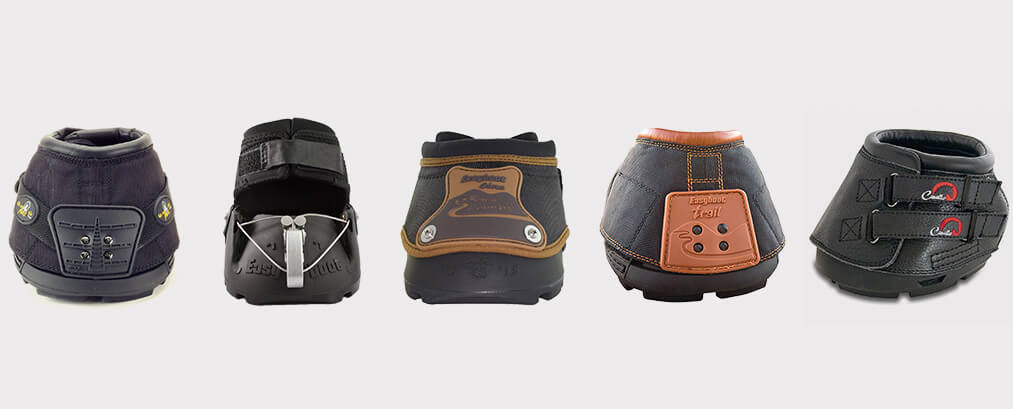Many barefooted horses will benefit from wearing hoof boots, especially through the transitionary phase after de-shoeing, and sometimes beyond
For example if extra shock absorption is required over challenging surfaces. If you think natural hoofcare is for you, then you have chosen a method of horse management that is challenging, but the benefits for the horse in terms of health, soundness, performance and longevity are well worth the extra effort.

Manufacturer Easycare has the following advice for anyone taking their horses’ barefoot:
Gone will be the days of arranging for the farrier every 6-8 week and not thinking any further about it. Below are some tips for the transition process, which is the period after de-shoeing while the horse becomes accustomed to his new life without shoes, barefoot.
- If your horse was sound in shoes, then he should be sound barefoot on grass and arenas. He is likely to be sensitive on rocky terrain until his soles thicken and develop a tough callus
- Hoof boots will allow you to continue riding on all surfaces during transition
- Some horses will always need boots on rocky terrain, especially if your circumstances don't allow for optimum diet and environment
- If your horse was lame in shoes than he may need some time off when the shoes are removed. Hoof boots with pads will get you back in the saddle as soon as possible
- Be patient and considerate. It may take time for the hooves to become healthy again. People are sometimes unrealistic when their horse first comes out of shoes, expecting the horse to cope immediately on long rides, and then when the horse struggles the shoes go back on.
- A lot of thought must be given to diet, the environment the horse lives in and the amount of movement the horse gets.
- Maintain hygiene to a high standard: the horse’s bedding must be clean and dry and the horse’s feet kept clean by picking them out every day
- The horse must be ridden with consideration using hoof boots when necessary
- Be prepared to tolerate the opinions of other horse owners who may feel that transitioning your horse out of shoes is unnecessary

Here are some common booting problems and FAQs-
With all makes and models of boots, you could encounter a problem, but this is usually to do with either the boot not being the best fit, or the horse’s hoof not being in the best condition at the time. The manufacturer or retailer will usually be able to advise on your horse’s individual needs.
Twisting
Twisting can be a simple indication that the hoof boot is either too big all over; if you are able to twist the boot yourself more than around 5 degrees when the horse’s foot is up, this is probably the most likely cause, and a smaller size or alternative model should be tried. It goes without saying that the better the boot fits, the less likely it is to twist, but if the horse has a natural twist in his gait (common in hind feet, or horses that dish), the correct fit is even more important.
If the boot fits well but still twists, you need to try and get the boot, and especially the width, as tight (without causing restriction) as possible. Brushing can also twist a boot; if your horse’s legs move close together, using thick brushing boots or fetlock boots behind, such as sheepskin lined versions or even a sausage boot, will usually keep the coronet bands far enough apart to prevent the horse from catching the boot.
Rubbing
Rubbing will occur if the boot is too small - check your measurements again and try the next size up to see if that fits better. Make sure the foot is really on the sole of the boot, and not crushing the heel. Boots that fit above the coronet band have the potential to rub, as they are making contact with more soft parts of the horse’s hoof and leg; some boots have special wraps or gaiters that act as ‘socks’ to help protect sensitive skin.
Horse is still sensitive with boots
If your horse is still reluctant to walk with boots on, and you have not already, you should consult a vet to rule out the possibility of laminitis or any other hoof-related problem. All boots should ideally be used with comfort pads; 12mm medium or soft foam pads or 1” thick ‘sole mate’ type pads work best for very sore horses.
Lost or broken boots
All good hoof boots are made to withstand a half tonne horse over miles of rugged terrain, but just like a horse can rip off a metal shoe, it is possible to lose a boot. If you lose a boot within the first week, or more than once in the first month, it is most likely the wrong style / shape / size for your horse’s hooves, and you should check the fit with the manufacturer or knowledgeable retailer first, to see if another size of style may be more appropriate. If you need to turn out in boots, choosing a boot that fits securely above the hairline usually works best.













